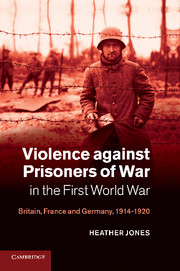Book contents
- Frontmatter
- Contents
- List of illustrations
- List of tables
- Acknowledgements
- Abbreviations
- Introduction
- Part I Propaganda representations of violence against prisoners
- Part II Violence and prisoner of war forced labour
- Part III The end of violence? Repatriation and remembrance
- Glossary of foreign terms
- Bibliography
- Index
Part II - Violence and prisoner of war forced labour
Published online by Cambridge University Press: 05 January 2014
- Frontmatter
- Contents
- List of illustrations
- List of tables
- Acknowledgements
- Abbreviations
- Introduction
- Part I Propaganda representations of violence against prisoners
- Part II Violence and prisoner of war forced labour
- Part III The end of violence? Repatriation and remembrance
- Glossary of foreign terms
- Bibliography
- Index
Summary
Introduction to part II
By 1916, important precedents had been set. As part I has shown, the image of the prisoner of war had become firmly associated with atrocity in cultural representations in Britain, France and Germany. This set in place an escalatory dynamic: representations of violence actually discursively popularised and legitimised the very violent practices against prisoners which they were intended to condemn, as they sparked calls for retaliation and also created cultural expectations of further atrocity among both civilians and military. The complex, symbiotic relationship which emerged between violent practices and the violent image, both textual and iconographic, during the early years of the war, thus fed cycles of violence against prisoners of varying intensity. This process, in turn, fuelled new violent propaganda images – and further mistreatment. Violence against prisoners was therefore not a stable constant. It was an ever-changing trajectory, influenced by frequently revised expectations regarding permitted and prohibited practices as well as by military necessity.
Prisoners themselves were complicit in this escalation dynamic, as exchanged and repatriated former captives were the main source of the information which fuelled their own representation. In this sense, prisoners were not the passive subjects of their own historicisation, as the media portrayed them. Statements from ex-prisoners largely determined the accusations made by the belligerent governments about prisoner atrocities; prisoner testimony was assessed by armies and governments, who tried to ascertain the extent of both positive and negative captivity experiences and draw overall conclusions about the accuracy of any mistreatment claims.
- Type
- Chapter
- Information
- Violence against Prisoners of War in the First World WarBritain, France and Germany, 1914–1920, pp. 121 - 126Publisher: Cambridge University PressPrint publication year: 2011

